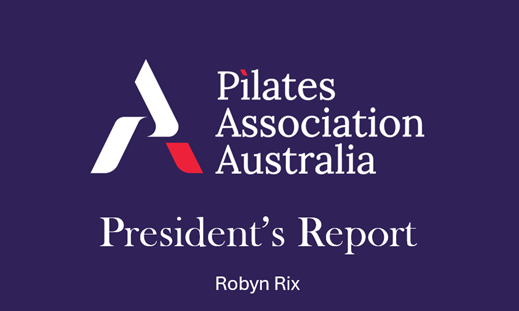
2025 AGM Report
PAA Annual General Meeting, 13 September 2025
Welcome to the 2025 AGM report, covering the 2024-25 financial year.
Apologies
Mary McArthur, Kerryn Joyce, Helen Simmons, Stephanie Kwok, Simone Ritchi
2024 AGM Minutes
Minutes of the previous AGM were accepted.
President’s Report
PAA President Robyn Rix opened the 2025 Annual General Meeting by welcoming members and reaffirming the Association’s mission—to advance the interests of the Pilates Method and its professionals—and our shared vision: for the Pilates Method to be recognised as a professional and valued health care and fitness discipline.
Key Projects and Achievements 2024–2025
- Planning for the 2025 Conference
Planning for the 2025 conference has been a major PAA project of the year: bringing together Australia’s Pilates professionals for education, collaboration, and inspiration. Those present agreed it was an overwhelming success.
- Health Fund Rebates & Professional Recognition
Over the past year, the PAA has made significant progress in advocating for the reintroduction of private health fund rebates for Pilates services and strengthening the professional recognition of Pilates practitioners.
Following the Natural Therapies Review (NTR), legislative changes took effect on 1 July 2025, allowing health funds once again to offer rebates for Pilates. As a result, HCF has already reinstated rebates for exercise services, which now include Pilates.
President Robyn Rix outlined the ongoing lobbying efforts with key industry bodies—including the Australian Regional Health Group (ARHG), Private Health Australia (PHA), and major funds such as NIB, Medibank Private, CBHS, and Bupa—to encourage broader reinstatement of Pilates coverage.
Discussions to date suggest several possible models for how Pilates may be reintroduced across funds:
- Healthy Lifestyle Programs: Offering $100–$150 per year, typically with GP referral
- Natural Therapies Cover: Restoring the previous rebate level of $300–$400 per year
- Enhanced Professional Category: A potential new tier providing rebates up to $600 per year
Eligibility for these rebates is expected to align with the Pilates Practitioner Level 2 credential—requiring 3,000 hours of practice or an advanced diploma—which positions Pilates professionals as credible health service providers.
Robyn also explained potential changes to professional development requirements for membership, including a 20-point catch-up requirement for lapsed or new members and a 20-hour annual requirement.
At present, HCF is the only health fund offering rebates for Pilates (since July 1), while Bupa has indicated it will not reintroduce Pilates cover at this stage.
The Association remains committed to advocating for fair and consistent recognition across all funds.
- Professional Standards & Recognition: Occupational Standard Classification for Australia (OSCA):
The PAA has been advocating for “Pilates Practitioner” to be reclassified under “Health Support Worker,” a change that could take several years and would be influenced by the next census.
Robyn spoke about progress toward national recognition of Pilates professionals within Occupational Standard Classification for Australia (OSCA) and has been advocating for “Pilates Practitioner” to be reclassified under “Health Support Worker.
She encourages members to identify as “Therapeutic Pilates Practitioners” in the upcoming census to strengthen data on the profession’s scope and value.
PAA continues to work with government agencies to ensure Pilates is appropriately classified within Australian occupational codes.
- Digital Engagement & Member Initiatives
Robyn highlighted several successful 2024/25 projects under the digital strategy:
- The new “Why Pilates” program aims to raise awareness of Pilates’ health benefits. This is a consumer-focused initiative aiming to increase public awareness of Pilates and drive inquiries to member studios. It will feature real-life stories of people doing Pilates and interviews with their instructors, interspersed with informational episodes and expert interviews
- The PAA Podcast and Pilates Science platform are gaining strong followings, with the latter now using AI tools to generate plain-language summaries of current research.
- The new membership management system (iMIS) launched in September 2024 has replaced Bookings Essential, improving efficiency and creating new opportunities for engagement.
Upcoming initiatives include Special Interest Groups (SIGs), a Mentoring Pilot, and an online library of educational content to support new teachers and bridge the gap between students and qualified instructors.
- Inter-Organisational Collaboration
The PAA is actively building relationships with other industry bodies and associations, both nationally and internationally, to advance the Pilates profession:
- Australian Physiotherapy Association (APA): Susie Bond (SB) regularly meets with the APA to improve their understanding of Pilates training levels and has co-authored articles for their InMotion publication. Efforts are ongoing to establish guidelines for Pilates training, similar to ESSA. A new contact, Bronwyn Darmanin, is liaising with private health funds.
- Pilates Method Alliance (PMA): The PAA is exploring reciprocal course recognition with the US-based PMA, having found their accreditation criteria largely align.
- Pilates Teachers Association (UK): Collaboration with Lesley McPherson to discuss global standards for Pilates teachers and consistent occupation codes.
These collaborations help promote global consistency in qualifications and professional standards.
Membership Strategy and Growth
At year-end, PAA had 539 paying members, including:
- 389 Practitioner Members
- 97 Group Instructors
- 43 Studio Instructors
- 10 Associate Members
plus 235 student members.
The Committee discussed strategies to grow membership and improve retention, particularly by converting student members to full membership upon graduation. While the idea of lowering Associate Member fees was considered, comparisons with other associations (such as AusActive) indicated the current structure remains fair.
A new initiative to support early-career teachers is being developed, with plans to create accessible online learning resources and mentoring opportunities. Robyn noted the importance of adapting to how younger professionals prefer to learn and connect.
Financial Report
Treasurer: Cheryl Burgess
Cheryl reported that the Association remains solvent with net assets of $99,280, down from $157,535 in the previous year—a reduction of $58,327.
Key financial shifts included:
- A 56.8% decrease in assessment fees (due to restructuring)
- A 174% increase in workshop revenue
- The cessation of the JBMT journal, saving approximately $15,000 annually
While membership income has improved, the Association aims to recruit at least 50 new members in the coming year and diversify income streams beyond conference revenue. Plans include a review of workshop PDP assessment format and expanded online education offerings.
Committee and Staff Recognition
A sincere thank you was given by Robyn to our dedicated staff:
- Sharan Simmons, Member Relations Officer
- Kerry Haywood, Systems Officer
- Natalie Ryan, Social Media Assistant
Special mention was made of Natalie’s achievements, with Social media engagement continuing to grow: Instagram followers up 21% (4,686) and Facebook up 4% (4,100).
Robyn also thanked the Committee for their ongoing dedication:
Susie Bond, Lisa Jackson, Cheryl Burgess, Karen Goh, Daniela di Fabio, Bruce Hildebrand, Donna Oliver, Arwen McCutcheon, and Olga Tamara, along with Sub-Committee member Deanne Castronini.
Elections
The number of nominations received was equal to vacant committee positions so there was no requirement for elections.
Robyn acknowledged Olga Tamara’s valuable contributions as she steps down from the Committee, and welcomed Kimberley Garlick as a new Ordinary Committee member.
Reaching the end of their first three year term, Karen Goh (Secretary) and Bruce Hildebrand (Ordinary Committee) are re-elected for another three years unopposed.
Introducing the 2025–2026 Committee:
- President: Robyn Rix
- Vice President: Susie Bond
- Treasurer: Cheryl Burgess
- Secretary: Karen Goh
- Education Chair: Lisa Jackson
- Ordinary Members: Bruce Hildebrand, Daniela di Fabio, Donna Oliver, Arwen McCutcheon, Kimberley Garlick
Closing Remarks
Robyn closed the meeting by thanking members for their continued commitment to the profession and to the Association’s mission. She reaffirmed the importance of community, collaboration, and advocacy in shaping the future of Pilates in Australia.
Together, we are building a stronger, more recognised, and more connected profession.

Comments are closed.